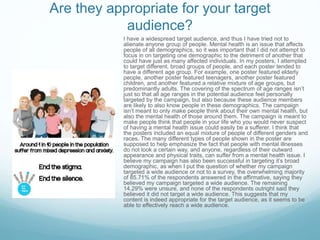The document discusses a social action campaign to end stigma surrounding mental health issues. The campaign included posters, a logo, and merchandise. The campaign aimed to raise awareness, provide facts about mental health, and challenge misconceptions. Survey results found that 71.43% of respondents learned something new from the campaign. The various elements of the campaign, including the posters, logo, slogan ("End the stigma. End the silence."), and merchandise are analyzed in terms of their effectiveness in meeting the goals and purposes of the campaign and clearly communicating its message to a broad target audience.












